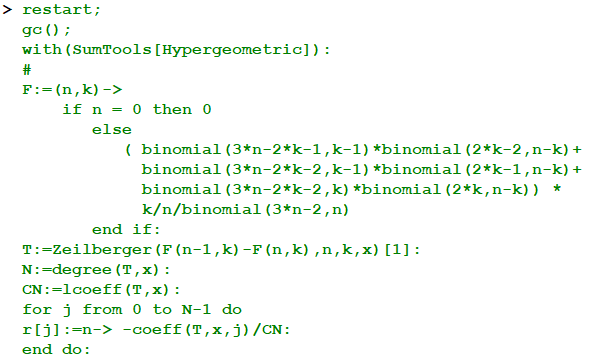Since this is a very similar question to another one already done, more than a partial answer, I will provide a detailed explanation to solve this kind of problems. I will try to apply it to this specific case.
First, you need support from some Math Symbolic Software. Either commercial soft, Mathworks Matlab, Maplesoft Maple or Wolfram's Mathematica or Non-commercial, Sage, Maxima. I will apply methods from Maple and Mathematica.
Second, even if you ask for a wide range of $n$ values. Solution is based on sequence asymptotics for $n>n_0$ and recurrences with some given or found $n_0$. Induction is applied from this point.
I. Asymptotics
Some basics are required (fractional powers of $n$ can be added accordingly)
If $$S_n=S+\frac{s_1}{n}+\frac{s_2}{n^2}+o(n^{-2}),\ S\ne 0$$ and $$S_{n+1}/S_n=R+\frac{r_1}{n}+\frac{r_2}{n^2}+o(n^{-2})$$ then $R=1,\ r_1=0,\ r_2=-s_1/S$. So that if 2 values of $[S,s_1,r_2]$ are known, the third one is also known. For $S,s_1>0$ the sequence $S_n$ is asymptotically decreasing since as $n\rightarrow\infty$ $$S_{n+1}/S_n=1-\frac{s_1}{S}\cdot\frac{1}{n^{2}}+o(n^{-2})<1$$ Your $S_n=A_n+B_n+C_n$ is the sum of 3 sequences of the same family. So that $S=A+B+C$ and $$S_n=A+B+C+\frac{a_1+b_1+c_1}{n}+\frac{a_2+b_2+c_2}{n^2}+o(n^{-2})$$For $\rho=\frac{a_1+b_1+c_1}{A+B+C}\ $ and $\ R_n=S_{n+1}/S_n$ $$R_n=1-\rho\cdot\frac{1}{n^{2}}+o(n^{-2})$$
To get $\rho$, you can apply for each sequence $A_n,B_n,C_n$ separatedly Ryabenko-Skorokhodov asymptotics (a big subset of Birkhoff and Trjitzinsky Theory on linear recurrence asymptotics) as implemented in Maple's function DefiniteSumAsymptotic(). This gives the limits $A,B,C$ immediately. It also gives numerically $a_1,b_1,c_1$, however you need to work with the last argument of this function to control some computing parameters. Transforming these values to rationals is simple.
So we have $$A_n=A+\frac{a_1}{n}+o(n^{-1})= \frac{3}{25}+\frac{96}{625}\frac{1}{n}+o(n^{-1})$$ $$B_n=B+\frac{b_1}{n}+o(n^{-1})= \frac{3}{25}+\frac{71}{625}\frac{1}{n}+o(n^{-1})$$ $$C_n=C+\frac{c_1}{n}+o(n^{-1})= \frac{9}{25}-\frac{132}{625}\frac{1}{n}+o(n^{-1})$$Therefore $S=3/5$,$\ s_1=7/125,$ and we get $\ \rho=7/75$, $$S_n=\frac{3}{5}+\frac{7}{125}\frac{1}{n}+o(n^{-1})$$ $$R_n=1-\frac{7}{75}\frac{1}{n^2}+o(n^{-2})$$ This last expression proves that $S_n$ is a decreasing sequence from some $n>n_0$
II.- Recurrences
On the other side, Zeilberger's algorithm allows to find and provide a proof of linear recurrences of order $\ell$ for holonomic (hypergeometric) sequences $Q_n$ $$p_\ell Q_{n+\ell}+p_{\ell-1} Q_{n+\ell-1}+...+p_1 Q_{n+1}+p_{0} Q_{n} =0$$ $$Q_{n+\ell}=q_{\ell-1} Q_{n+\ell-1}+...+q_1 Q_{n+1}+q_{0} Q_{n} $$where $p_\ell$ and $q_\ell$ are polynomials and rationals in $n$ respectively. If you map $Q_{n+\ell}\leftrightarrow y^\ell$ and solve the polynomial equation asymptotically for $y$ as $n\rightarrow\infty$ (using, for instance, AsymptoticSolve[] from Wolfram's Mathematica™) you get the asymptotic leading expression for $Q_{n+1}/Q_n$. For the kind of sequences (logarithmically convergent sequences) you are working on, the polynomial solution $y\rightarrow 1$ as $n\rightarrow\infty$ must be selected.
Zeilberger's algorithm is implemented in Maple™, Maxima™ and Mathematica™ using Sigma™ package. [Sigma - A summation package by Carsten Schneider \ © RISC \ V 2.89 (November 10, 2021)]
We use Zeilberger on $A_n$,$\,B_n\,$ and $\,C_n$ to get recurrences of order 4 with polynomial degrees 15, 16 and 16 respectively. Asymptotic polynomial roots for $y\rightarrow 1$ are $$A_{n+1}/A_n=1-\frac{32}{25}\frac{1}{n^2}+o(n^{-2})$$ $$B_{n+1}/B_n=1-\frac{71}{75}\frac{1}{n^2}+o(n^{-2})$$ $$C_{n+1}/C_n=1+\frac{44}{75}\frac{1}{n^2}+o(n^{-2})$$ Therefore for $\left[A,B,C\right]=\left[\frac{3}{25},\frac{3}{25},\frac{9}{25}\right]$ we recover $\left[a_1,b_1,c_1\right]=\left[\frac{96}{625},\frac{71}{625},-\frac{132}{625}\right]$ and $\rho=\frac{7}{75}$
To prove that $S_n$ decreases from some $n_0,\,$ ($n_0 = 5$ in this case), it is convenient to work with $T_n=S_{n-1}-S_n$ and prove that $T_n>0$ for all $n>n_0$. Applying
Algorithm provides a recurrence of order 4 with polynomials of degree 12, giving $$T_{n+4}=r_3\,T_{n+3}+r_2\,T_{n+2}+r_1\,T_{n+1}+r_0\,T_{n}$$ where rational coefficients (depending on $n$) $\ r_1,\ r_2,\ r_3$ are positive and $r_0$ is negative. (If every $r_j$ were positive $T_{n+4}>0$ would follow immediately by induction starting at the first values from $n_0=5$). Coefficient limits are $[r_0,r_1,r_2,r_3]\rightarrow[\frac{-32}{59049},\frac{101}{6561},\frac{15404}{59049},\frac{176}{243}]\ $ as $\ n\rightarrow\infty$. Note that $T_n$ is an asymptotically decreasing sequence, as it is proved using the above tools, in fact $$T_{n+1}/T_n = 1-\frac{2}{n}+o(n^{-1})$$ We need now a bound such that for some $\alpha<0$ and $n>3$ $$r_0\,T_n > \alpha\,r_1\,T_{n+1}$$ $$T_{n+4}>r_3\,T_{n+3}+r_2\,T_{n+2}+(1+\alpha)\,r_1\,T_{n+1}$$By taking $\alpha=(1+\epsilon_n)\cdot\lim_{n\rightarrow\infty}r_0/r_1\,$ with $\,\epsilon_n=15/n$ and the limit ratio we obtain $$\alpha=-\frac{32}{909}\left(1+\frac{15}{n}\right)$$ Since $(1+\alpha)\,r_1,r_2,r_3>0$ for $n>3$, we get $T_{n+4}>\left([1+\alpha]\,r_1+r_2+r_3\right)\cdot T_{n+3}$ or equivalently $$T_{n+1}>\gamma(n)\cdot T_n$$with $\gamma(n)>0$ for $n>n_0$. A simple proof by induction complete these steps.
All this process can be coded and performed on an appropiate software platform.


